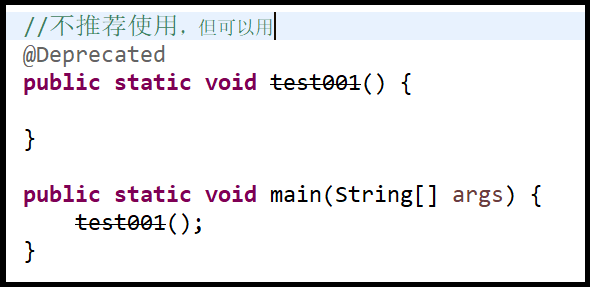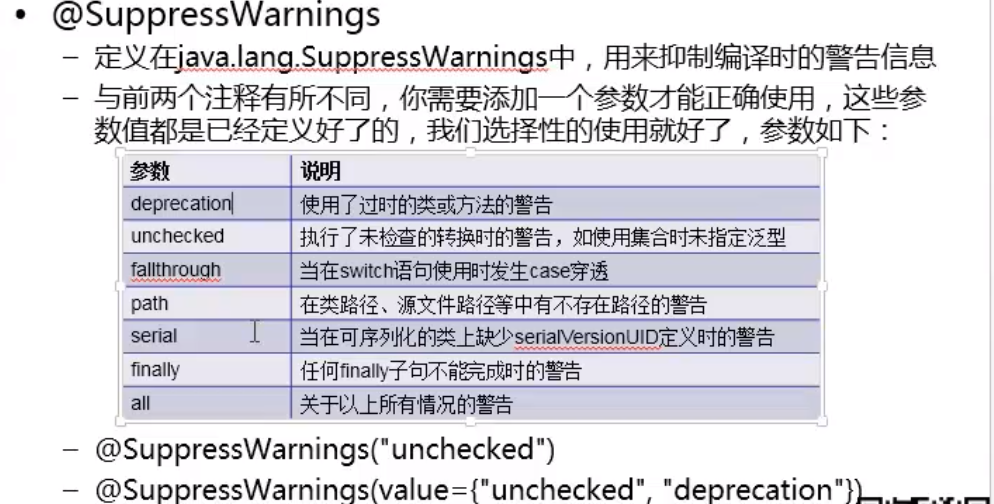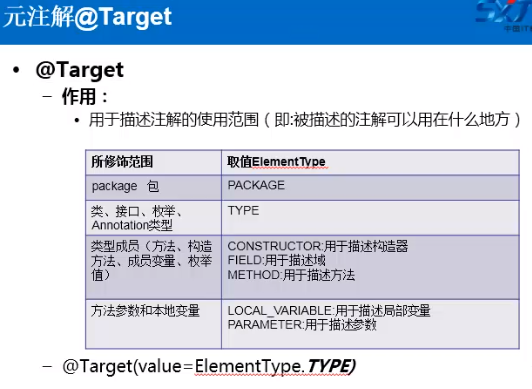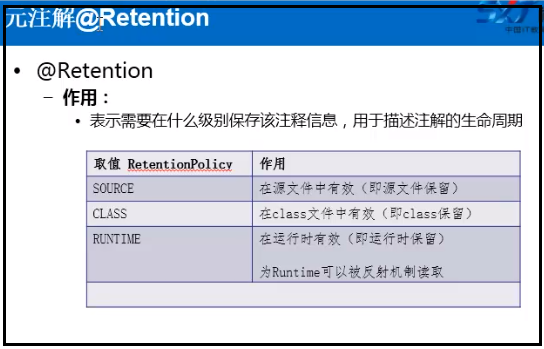1.什么是注解?
Annotation是JDK5.0开始引入的新技术。
Annotation的作用:
- 不是程序本身,可以对程序作出解释。(这一点,跟注释没什么区别)
- 可以被其他程序(比如:编译器)读取。(注解信息处理流程,是注解和注释的重大区别)
Annotation的格式:
--注解是以“@注释名”在代码中存在的,还可以添加一些参数值,例如:@SupperssWarnings(value="unchecked")。
Annotation在哪里使用?
--可以附加在package,class,method,field等上面,相当于给他们添加了额外的辅助信息,我们可以通过反射机制编程实现对这些 元数据的访问。
2.内置注解
@Override ----(重写)
定义在java.lang.Override中,此注释只适用于修辞方法,表示一个方法声明打算重写父类中的另一个方法声明。
package java.lang; import java.lang.annotation.*; @Target(ElementType.METHOD) @Retention(RetentionPolicy.SOURCE) public @interface Override { }
@Deprecated ----(不推荐使用,带有一个中划线)
定义在java.lang.Deprecated中,此注释可用于修辞方法、属性、类,表示不鼓励程序员使用这样的元素,通常是因为它很危险或存在更好的选择。

package java.lang; import java.lang.annotation.*; import static java.lang.annotation.ElementType.*; @Documented @Retention(RetentionPolicy.RUNTIME) @Target(value={CONSTRUCTOR, FIELD, LOCAL_VARIABLE, METHOD, PACKAGE, PARAMETER, TYPE}) public @interface Deprecated { }
@SuppressWarnings ----(抑制警告)
定义在java.lang.SuppressWarnings中,用来抑制编译时的警告信息。

package java.lang; import java.lang.annotation.*; import static java.lang.annotation.ElementType.*; @Target({TYPE, FIELD, METHOD, PARAMETER, CONSTRUCTOR, LOCAL_VARIABLE}) @Retention(RetentionPolicy.SOURCE) public @interface SuppressWarnings { String[] value(); }
3.自定义注解
关键字@interface
元注解的作用就是负责注解其他注解。Java定义了4个标准的meta-annotation类型,它们被用来提供对其它annotation类型作说明。
这些类型和它们所支持的类在java.lang.annotation包中可以找到
----@Target
----@Retention
----@Documented
----@Inherited
1.@Target的源码及作用范围
ElementType类型是一个枚举类型,里面都是固定的值
package java.lang.annotation; @Documented @Retention(RetentionPolicy.RUNTIME) @Target(ElementType.ANNOTATION_TYPE) public @interface Target { //参数类型 参数名 ElementType[] value(); }
ElementType:
package java.lang.annotation; //枚举 public enum ElementType { TYPE, FIELD, METHOD, PARAMETER, CONSTRUCTOR, LOCAL_VARIABLE, ANNOTATION_TYPE, PACKAGE, /** * Type parameter declaration * * @since 1.8 */ TYPE_PARAMETER, /** * Use of a type * * @since 1.8 */ TYPE_USE }
其作用是给自定义的注解,描述它能加到什么地方。

2.@Retention的源码及作用范围
注解保留策略(RetentionPolicy)
package java.lang.annotation; @Documented @Retention(RetentionPolicy.RUNTIME) @Target(ElementType.ANNOTATION_TYPE) public @interface Retention { //也是一个枚举类型 参数名 RetentionPolicy value(); }
RetentionPolicy:
package java.lang.annotation; //枚举 public enum RetentionPolicy { SOURCE, CLASS, RUNTIME }

示例:
自定义的注解:
import java.lang.annotation.ElementType; import java.lang.annotation.Retention; import java.lang.annotation.RetentionPolicy; import java.lang.annotation.Target; //这就表示自定义注解只能用在方法上和类上 @Target(value = {ElementType.METHOD,ElementType.TYPE})//可以写到数组中 @Retention(value = RetentionPolicy.RUNTIME)//表示注解在运行时有效,可被反射(运行时)读取到 public @interface MyAnnotation { //写内容 // 参数类型 参数名 默认值 public String name() default "";//加了默认值 "" public int age() default 0; //表示不存在 int id() default -1;//int indexOf("abc") 返回子字符在字符串中第一次出现的索引,如果没有的话,返回-1,也就是表示不存在 String[] schools() default {"清华大学","北京大学"}; }
package com.xjs.annotation; import java.lang.annotation.ElementType; import java.lang.annotation.Retention; import java.lang.annotation.RetentionPolicy; import java.lang.annotation.Target; @Target(value = {ElementType.METHOD,ElementType.TYPE}) @Retention(value = RetentionPolicy.RUNTIME) public @interface XJSAnnotation { String value(); }
使用:
import com.xjs.annotation.XJSAnnotation; public class Demo2 { @MyAnnotation(age=18,name="金泰妍") public void test() { } @XJSAnnotation("taeyeon") public void test2() { } }

例子:
1.注解的解析完全依赖于反射。
2.不要滥用注解,平常我们编程过程很少接触和使用注解,只有做设计,且不想让设计有过多的配置时。
Student.java:
package com.xjs.annotation; //使用注解,使这个类和表对应 @XJSTable(value = "tb_student") public class Student { @XJSField(columnName = "id", length = 10, type = "int") private int id; @XJSField(columnName = "sname", length = 10, type = "varcher") private String name; @XJSField(columnName = "age", length = 3, type = "int") private int age; public Student() { super(); // TODO Auto-generated constructor stub } public Student(int id, String name, int age) { super(); this.id = id; this.name = name; this.age = age; } public int getId() { return id; } public void setId(int id) { this.id = id; } public String getName() { return name; } public void setName(String name) { this.name = name; } public int getAge() { return age; } public void setAge(int age) { this.age = age; } @Override public String toString() { return "Student [id=" + id + ", name=" + name + ", age=" + age + "]"; } }
自定义注解XJSTable.java:
package com.xjs.annotation; import java.lang.annotation.ElementType; import java.lang.annotation.Retention; import java.lang.annotation.RetentionPolicy; import java.lang.annotation.Target; @Target(value = {ElementType.TYPE}) @Retention(value = RetentionPolicy.RUNTIME) //自定义注解 public @interface XJSTable { String value(); }
自定义注解XJSField.java:
package com.xjs.annotation; import java.lang.annotation.ElementType; import java.lang.annotation.Retention; import java.lang.annotation.RetentionPolicy; import java.lang.annotation.Target; @Target(value = {ElementType.FIELD})//加在属性上 @Retention(value = RetentionPolicy.RUNTIME) public @interface XJSField { String columnName();//列名 String type();//类型 int length();//长度 }
利用反射机制解析该类上加的注解Demo3.java:
package com.xjs.annotation; import java.lang.annotation.Annotation; import java.lang.reflect.Field; /** * 使用反射读取注解的信息,模拟处理注解信息的流程 * @author hp * */ public class Demo3 { public static void main(String[] args) { try { Class clazz = Class.forName("com.xjs.annotation.Student"); Annotation[] annotations = clazz.getDeclaredAnnotations();//获得这个类的所有注解 for (Annotation annotation : annotations) { System.out.println(annotation); } //获得类指定的注解 XJSTable xt= (XJSTable) clazz.getDeclaredAnnotation(XJSTable.class); System.out.println(xt.value());//获取这个类上的注解的value值 //获得类的属性的注解 Field f = clazz.getDeclaredField("name"); XJSField xjsFile = f.getAnnotation(XJSField.class); System.out.println(xjsFile.length()); //根据获得的表名,字段的信息,拼出SQL语句,然后,使用JDBC执行这个SQL,在数据库中生成相关的表的记录 /* * 注解--->依赖反射,然后获取信息 * 对象的每一个属性信息---JDBC--->通过SQL语句添加到数据库中对应的字段 * */ } catch (Exception e) { e.printStackTrace(); } } }